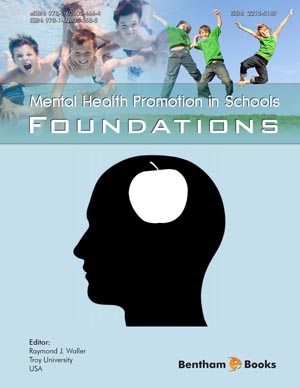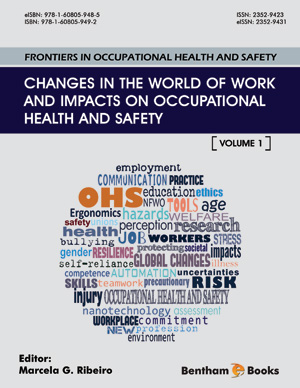Book Volume 1
List of Contributors
Page: ix-xi (3)
Author: Raymond J. Waller
DOI: 10.2174/9781608054664112010100ix
Mental Health Treatment or Promotion in Resource Allocation: Two Topical Considerations Elucidate the Road Less Traveled
Page: 3-27 (25)
Author: Raymond J. Waller, Carol L. Albertini and Nancy L. Kupfrian
DOI: 10.2174/978160805466411201010003
PDF Price: $15
Abstract
As a group of strategies, mental health promotion may better serve the needs of children than the treatment of a mental disorder already manifested. The school setting is more amenable to promotion than treatment, and more aligned with the mission of schools as well for several reasons. The purpose of this chapter is to discuss two of the criteria often involved in the complex decisional matrix involved in resource allocation regarding mental health outcomes: 1) which option provides the best outcome for the investment and 2) which alternative conveys the highest probability of accurate diagnosis/effective treatment selection. Finally, a case study involving mental health promotion strategies in schools to support and assist in the reduction of symptomatology in a diagnosed mental disorder is provided.
Increasing School Attendance: The First Step in Promoting Mental Health
Page: 28-48 (21)
Author: Steven G. Little, Angeleque Akin-Little and Joshua Couperus
DOI: 10.2174/978160805466411201010028
PDF Price: $15
Abstract
Among the variety of topics that are keystones for the promotion of mental health in schools, an issue that may go unaddressed-perhaps because it seems so elementary-is this: before student mental health can be supported in school, students must be in school. Evidence of failure to get students in school is seen not only in daily attendance rates, but is reflected in other sources of evidence including the surprisingly low high school graduation rates and in truancy data. Absenteeism is among the most serious threats impacting school success and has been shown to be associated with a variety of factors such as the school environment, home environment, and individual student characteristics. The goal of this chapter is to explicate the influences impacting attendance such that educators can effectively plan for success in this most basic requirement for promoting mental health in schools.
Student Engagement and Disengagement: An Intrinsic Motivation Perspective and a Mental Health Concern
Page: 49-75 (27)
Author: Howard Adelman and Linda Taylor
DOI: 10.2174/978160805466411201010049
PDF Price: $15
Abstract
The recognition that school is a necessary cite in the positive mental health of children has become widespread, though the importance of mental health promotion in schools is not as universally understood and appreciated. A difficult reality is that students enter school with a variety of behavioral, emotional, and learning needs, complicating the goals and expectations placed on professional educators. Nonetheless, the manner in which children engage in the relationships, environment, and societal and cognitive requirements faced in school are not always acknowledged and addressed in educational programming. This chapter discusses challenges and opportunities for educational professionals within the context of the best current information available on effective and positive engagement of students in the global school experience.
Teacher-Student Relationships in Mental Health Promotion
Page: 76-104 (29)
Author: Melissa R. Dvorsky, Leslie K. Taylor and Mark D. Weist
DOI: 10.2174/978160805466411201010076
PDF Price: $15
Abstract
As more evidence has accumulated regarding child and adolescent development and school mental health promotion has promulgated, significant variables correlated with mental health promotion have emerged with repetition and replication. One such variable is the importance of teacher student relationships. High quality teacher student relationships are necessary components of school’s mental health promotion and, more broadly, comprehensive school performance. Conversely, such matters as negative attributions toward student ability and behavior and teacher student conflicts both tend to constrain desirable student outcomes and are disposed to be highly recalcitrant to change. This chapter summarizes data on these issues, provides strategies for enhancing teacher student relationships that stimulate mental health and optimizing positive outcomes, discusses influences that hinder positive relationships and remediate negative relationships that may already exist, and concludes with a brief discussion of future investigation that will advance our knowledge of this important area.
Response to Intervention: A Proactive Approach Addressing a Spectrum of Student Need
Page: 105-126 (22)
Author: Allison Nealy
DOI: 10.2174/978160805466411201010105
PDF Price: $15
Abstract
Response to intervention is a proactive approach addressing the needs of students who do not progress at the expected pace or at a rate commensurate with peers. With this approach, students receive additional needed assistance through the ongoing collection and analysis of data, progress monitoring, and implementation of evidence based practices across all levels of student needs. Intervention without exclusion is emphasized. Avoidance of failure is a paramount concern, and early, intense assistance is an additional focus. Response to intervention was outlined in the newest authorization of the Individuals with Disabilities Education Act, and has been adopted in several states. Though the approach began in the area of learning disabilities, it has been expanded to other domains. Many scholars and practitioners have likewise conceptualized response to intervention to address students’behavioral concerns. This chapter describes response to intervention and proposes that it may be a model for meeting student needs that promotes student mental health in the school setting.
The Contribution of Extracurricular Activities to School Priorities and Student Success
Page: 127-148 (22)
Author: Aidyn L. Iachini and Dawn Anderson-Butcher
DOI: 10.2174/978160805466411201010127
PDF Price: $15
Abstract
In response to the momentous challenges schools face in meeting the diverse and growing needs of students, many schools have expanded their school improvement priorities beyond academic learning. Health and social services, youth development, parent/family engagement, and community partnership development are four additional school improvement pathways of growing importance. Many schools also are focusing on how these priorities are addressed in the out-of-school time hours, particularly as a way to complement and extend learning and development that occurs during the hours of the school day. Extracurricular activities are examples of out-of-school time opportunities provided by many schools that can have an important impact on school priorities and student success. The purpose of this chapter is to highlight how extracurricular activities can contribute to these five school improvement pathways. Data collected from 21st Century Community Learning Centers from Ohio are provided as an example. Implications for school leaders and practitioners in relationship to maximizing the impact of extracurricular activities on school priorities and student success also are shared.
Positive Approaches to Behavior Management: Friend or Beast of Burden for Professional Educators?
Page: 149-164 (16)
Author: Kim Sheffield and Raymond Raymond
DOI: 10.2174/978160805466411201010149
PDF Price: $15
Abstract
An opportunity to affect entire student populations in the effort to promote mental health but that resists being universally applied is the use of positive behavior management approaches. In many schools, behavior management based on variables that tend to negatively impact school engagement and functioning still predominates in some locations. Such behavior management approaches are based on interventions emphasizing factors such as punishment for rule violations rather than teaching and reinforcing rule adherence. The continued use of negative approaches to behavior management is puzzling, since substantial data supports numerous positive behavior management methodologies and techniques. One approach thus described is functional behavior assessment and functionbased intervention planning. Though sometimes criticized as too difficult or impractical for the typical classroom teacher, we propose that, given certain caveats, educators can employ the techniques effectively and with positive results. This review summarizes a sample of the literature on function-based interventions utilized by teachers to reduce disruptive behaviors of students. This review was included in 20 articles published between 2001 and 2009 across 9 peer-reviewed journals. Studies included in the review met the following criteria: teachers implemented the interventions utilized as well as participated in the intervention development process; students displayed disruptive behavior that interfered with their own or others academic success; and each intervention was function-based, meaning it was created from data collected and analyzed from a functional behavioral assessment. The reviewed studies support the contention that teachers can implement function-based interventions and participate in the process of creating the interventions utilized to reduce disruptive behavior of students.
Risk and Resilience in Middle Childhood: Lessons for School Mental Health Promotion
Page: 165-203 (39)
Author: Daisy R. Jackson and Elise Cappella
DOI: 10.2174/978160805466411201010165
PDF Price: $15
Abstract
Unresolved mental health issues are associated with numerous negative outcomes, both short and long term, for school-aged children. Although effective interventions exist for many mental health conditions, primary prevention of these maladies, whenever possible, is clearly in a child’s best interest. Mental health promotion in schools is a viable medium for nurturing prevention. Among the most potent influences schools can affect in the efforts to promote mental health are risk and resiliency factors in a child’s environment. Exposure to risk factors is strongly associated with negative mental health outcomes, while the presence of protective factors is strongly predictive of positive mental health outcomes and ultimately pronounced improvements in quality of life. School performance can ultimately be among the most formidable risk or resilience factors, depending on the qualitative and quantitative experience of the individual student. Further, the school has the ability to exert influence on other risk and resilience factors in a student’s environment. This chapter delineates risk and resilience factors that have been found to profoundly affect mental health and quality life, evidence-based practices that have been applied to foster positive outcomes, and provides sufficient foundation on the current knowledge base on risk and resilience to facilitate school planning in programming for maximizing student mental health outcomes.
Culturally Responsive Education: Promoting the Mental Health of All Students for Stronger, Inclusive Communities
Page: 204-230 (27)
Author: JoEtta Gonzales
DOI: 10.2174/978160805466411201010204
PDF Price: $15
Abstract
Meeting the challenge of educating all students within the U.S. has taken on a new meaning in this age of accountability. There is a plethora of data that points to a crisis that is neither silent nor invisible. One example includes dropout rates which are high for all students, but when we look at data for our culturally and linguistically diverse students in particular, we find that our nation’s schools have failed to hold on to more than 50% of all students who are African American, Latino, and/or Native American (Orfield, Losen, Wald, & Swanson, 2004; Swanson, 2004). Improvement efforts at many of these schools have focused on technical pedagogical solutions that have come up short on impacting national trends. A better approach includes systemic, comprehensive, and transformative interventions embraced simultaneously by educators at all levels of the school system. This chapter, focuses on culturally responsive education, emphasizes the need for educators to understand and build upon cultural identity in order to embrace the key features of culturally responsive education. The content will assist readers in applying their new knowledge to begin planning for and creating everyday culturally responsive practices within their own settings.
System of Care for Children with Severe Emotional Disturbance: A Framework of Mental Health Promotion Based on Students Most in Need
Page: 231-273 (43)
Author: Denise M. Green and Sarah E. Twill
DOI: 10.2174/978160805466411201010231
PDF Price: $15
Abstract
The purpose of this chapter is to provide the reader with information concerning current definitions of the term Severe Emotional Disturbance, a brief history of public care provisions for children with Severe Emotional Disturbance, a historical review of the System of Care movement defining the model as a Best Practices Model of service delivery for children with Severe Emotional Disturbance, and an example case study utilizing a System of Care model. Also, the most common mental health conditions typically diagnosed in school-aged children are discussed. It is hoped that dialogue regarding students with the highest level of need, will provide the reader with a broad perspective on the mental system of care resources available for children and adolescents. Creative collaboration among involved—and other potential system of care members—can be tantamount in pursuit of effective mental health promotion provided that participants adhere to principals discussed previously in this text and avoid detrimental philosophy and intervention strategies such as coercive control techniques.
Introduction
Behavior problems are approaching epidemic levels in many schools and mental health issues in school-aged children is an international concern. Similarly, parents, caregivers, and other concerned adults report behavioral disturbances in homes and in other settings despite the ongoing effort to ease access to mental health services. Student mental health has also been demonstrated to have a direct impact on student behavior and performance. This book discusses methods by which educators can promote student mental health, similar to the ways in which schools already promote physical health. Promoting student mental health may mean doing things differently than are currently being done, but does not involve doing more than what is already is being done. Professional educators, counselors and readers interested in public mental health matters will greatly benefit from this book.












